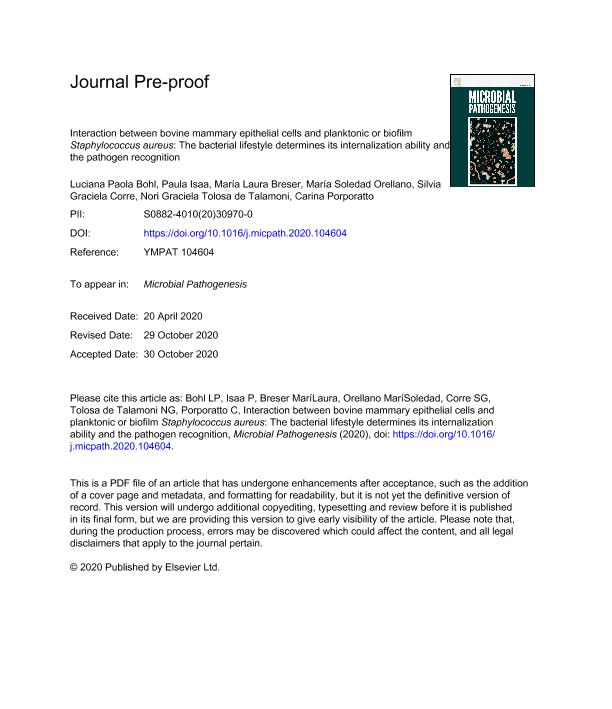Artículo
Interaction between bovine mammary epithelial cells and planktonic or biofilm Staphylococcus aureus: The bacterial lifestyle determines its internalization ability and the pathogen recognition
Bohl, Luciana Paola ; Isaac, Paula
; Isaac, Paula ; Breser, Maria Laura
; Breser, Maria Laura ; Orellano, María Soledad
; Orellano, María Soledad ; Correa, Silvia Graciela
; Correa, Silvia Graciela ; Tolosa, Nori Graciela
; Tolosa, Nori Graciela ; Porporatto, Carina
; Porporatto, Carina
 ; Isaac, Paula
; Isaac, Paula ; Breser, Maria Laura
; Breser, Maria Laura ; Orellano, María Soledad
; Orellano, María Soledad ; Correa, Silvia Graciela
; Correa, Silvia Graciela ; Tolosa, Nori Graciela
; Tolosa, Nori Graciela ; Porporatto, Carina
; Porporatto, Carina
Fecha de publicación:
03/2021
Editorial:
Academic Press Ltd - Elsevier Science Ltd
Revista:
Microbial Pathogenesis
ISSN:
0882-4010
e-ISSN:
1096-1208
Idioma:
Inglés
Tipo de recurso:
Artículo publicado
Clasificación temática:
Resumen
The main cause of mastitis, one of the most costly diseases in the dairy industry, is bacterial intramammary infection. Many of these bacteria are biofilm formers. Biofilms have been associated with resistance to antibiotics and to the host immune system. Here, we evaluated different experimental models representing bacterial biofilm lifestyle with the aim to study bacterial invasion into bovine mammary epithelial cells and the interaction of these cells with planktonic or biofilm Staphylococcus aureus. Staphylococcus aureus V329, its nonbiofilm-forming mutant and bovine mammary alveolar cells (MAC-T) were used. Bacterial invasion was studied using the gentamicin exclusion test, cell viability by trypan blue exclusion technique, TLR2 expression by flow cytometry, IL1β/IL6 production by ELISA and IL8/TNFα gene expression by real-time polymerase chain reaction. Biofilm and planktonic S. aureus showed differences in their invasion ability, with the biofilm mode showing a lower ability. Planktonic S. aureus reduced MAC-T viability after 6 h of co-culture, while biofilms did so at 24 h. MAC-T infected with planktonic bacteria showed increased TLR2 expression. Both lifestyles increased IL8 expression and IL1β/IL6 production but did not modify TNFα expression. Our results demonstrate that the bacterial lifestyle affects the invasion behavior, suggesting that biofilms reduce the bacteria-epithelial cell interaction. Planktonic cultures seem to induce higher cellular activation than biofilms. Further knowledge about the complex host-biofilm interaction is necessary to design more efficient therapies against bovine mastitis.
Archivos asociados
Licencia
Identificadores
Colecciones
Articulos (IDAS)
Articulos de INSTITUTO PARA EL DESARROLLO AGROINDUSTRIAL Y DE LA SALUD
Articulos de INSTITUTO PARA EL DESARROLLO AGROINDUSTRIAL Y DE LA SALUD
Articulos(CCT - CORDOBA)
Articulos de CTRO.CIENTIFICO TECNOL.CONICET - CORDOBA
Articulos de CTRO.CIENTIFICO TECNOL.CONICET - CORDOBA
Articulos(CIBICI)
Articulos de CENTRO DE INV.EN BIOQUI.CLINICA E INMUNOLOGIA
Articulos de CENTRO DE INV.EN BIOQUI.CLINICA E INMUNOLOGIA
Articulos(INICSA)
Articulos de INSTITUTO DE INVESTIGACIONES EN CIENCIAS DE LA SALUD
Articulos de INSTITUTO DE INVESTIGACIONES EN CIENCIAS DE LA SALUD
Citación
Bohl, Luciana Paola; Isaac, Paula; Breser, Maria Laura; Orellano, María Soledad; Correa, Silvia Graciela; et al.; Interaction between bovine mammary epithelial cells and planktonic or biofilm Staphylococcus aureus: The bacterial lifestyle determines its internalization ability and the pathogen recognition; Academic Press Ltd - Elsevier Science Ltd; Microbial Pathogenesis; 152; 3-2021; 1-8
Compartir
Altmétricas



